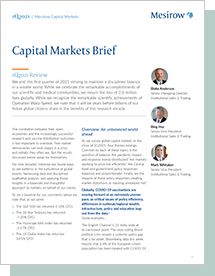Insights
1Q2021 Capital Markets Brief
Share this article
1Q2021 Review
We end this first quarter of 2021 striving to maintain a disciplined balance in a volatile world. While we celebrate the remarkable accomplishments of our scientific and medical communities, we mourn the loss of 2.6 million lives globally. While we recognize the remarkable scientific achievements of Operation Warp Speed, we note that it will be years before billions of our fellow global citizens share in the benefits of this research miracle.
The correlation between free, open economies and the increasingly successful research and vaccine distribution outcomes is too important to overlook. Free market democracies can look sloppy in a crisis, and initially they often are. But the results discussed below speak for themselves.
For nine decades, Mesirow has found ways to see patterns in the turbulence of global events, harnessing data and disciplined qualitative analysis, and applying those insights in a balanced and thoughtful approach to markets on behalf of our clients.
To set a baseline for our comments below we note that, as we write:
- The S&P 500 has returned 6.18% QTD
- The 10 Year Treasury has returned -7.20% QTD
- The Municipal AAA Index has returned -3.17% QTD
- The US Dollar Index has returned 3.65% QTD
Overview: An unbalanced world ahead
As we survey global capital markets at the close of 1Q2021, four themes emerge. Common to each of these topics is the question of balance. Are pandemic impact and response evenly distributed? Are markets working to price risk efficiently? Are Central Bank and government policy responses balanced and proportionate? Finally, are the impacts of these policy responses creating market distortions or masking unrealized risk?
Globally, COVID-19 vaccinations are moving forward at an extremely uneven pace, as critical issues of policy efficiency, differences in national/regional wealth, infrastructure, policy and education leap out from the data.1
Some examples:
The English Channel is 21 miles wide at its narrowest point. The slow-rolling Brexit political crisis reveals a systemic policy gap that is far wider. Bloomberg data this week reports that 6.4% of the European Union population has been treated with COVID-19 vaccine versus 22.4% in the United Kingdom (data adjusted by BB for dosing protocols2). Germany extended, then rescinded another four weeks of shutdown after a ferocious public pushback, as the UK implements reduced internal restrictions effective March 29, 2021. These two data points have implications for human health and well-being, economic growth, markets, education and trade policy; not to mention deep threats to contract law regarding the distribution of AstraZeneca vaccine shipments. 21 miles and a world apart.

1. Source: Bloomberg, 3.21.21.
2. Readers will have seen higher vaccination percentage data in headline press coverage. We have focused on Bloomberg data which has been adjusted for dosing protocols by vaccine (2x or 1X required) as a more comparably accurate approach. For example, the British focus on first dose produces a 59% adult one dose population vs. 38% in the US. More Americans are fully vaccinated at a rate of almost 3x the rate of British full vaccination. Thus, we’ve utilized Bloomberg’s adjusted data in the interest of data equivalency.
Spark
Our quarterly email featuring insights on markets, sectors and investing in what matters
